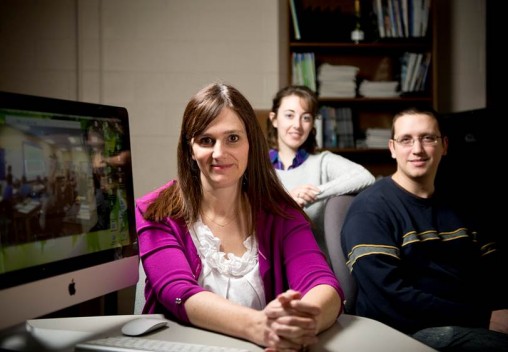
From left, Wright State associate professor Lisa Kenyon and graduate students Jeannette Loyer and Mackenzie English are part of a National Science Foundation grant investigating how science is taught to grade-school students.
Memorize. Recite. Move on. That teaching formula may soon be a thing of the past.
Wright State University researchers are on the brink of helping change the traditional model for teaching science by making learning more meaningful for elementary and middle-school students and moving them into a higher form of reasoning.
Lisa Kenyon, Ed.D., associate professor of biological sciences and teacher education, is leading Wright State’s effort as part of a five-year, $3.5 million grant from the National Science Foundation.
“We’re trying to move past rote learning to a place where students investigate the knowledge and connect their ideas in order to deepen their understanding,” Kenyon said. “We’re attempting to make them more scientific thinkers.”
Wright State, which is collaborating with Northwestern University, Michigan State and Wisconsin in the research, is in the fourth year of the grant and has a $350,000 share.
Kenyon said she and three Wright State graduate student researchers are trying to help students participate in the construction of knowledge through the scientific practice of arguing over evidence or explaining a mechanism or using a model to show how and why something happens.
Conventional teaching about evaporation/condensation, for example, would entail the teacher writing down the definition, having students memorize it, giving them a worksheet and then testing them.
“If you ask a student to explain evaporation/condensation, they can’t get past the definition because they really don’t understand it,” Kenyon said.
Under the new method, the students are asked from where water comes and over a period of time must explore concepts, construct models, form a conceptual model in their heads and then explain how evaporation/condensation occurs.
“It’s pretty amazing because they collect data, then they learn they can revise and change their concept,” Kenyon said. “So they are using a model as a thinking tool to help them figure things out.”
She said the students do a deeper analysis of a scientific concept, not just agree with what is presented to them. They ask better questions, see that their opinions matter, take criticism well and become more confident and enthusiastic, she said.
The researchers are working with about 100 students in local school districts in grades six through eight. The students learn about physics, chemistry, geology and life sciences through the new teaching concepts and build up those learning skills over time.
The researchers tape interviews with the students multiple times over the school year to look for patterns of practice to see if the students’ explanations are becoming stronger and their models are improving. A total of 700 students are being tracked in Dayton, Illinois and Michigan.
Kenyon said many of the students find the transition difficult at first, but then quickly begin to appreciate how much they are learning.
“It’s neat to see,” she said.
Kenyon has been invited to present the new teaching practices to about 90 elementary and middle-school teachers at a conference in Houston.
“If we can show that kids over time improve in the practices, reason better, become scientific thinkers, then we would hope that other curriculum would follow,” she said. “The next step is to teach teachers.”
Kenyon hopes the teaching practices will help produce a new generation of American citizens who look at issues through a scientific lens and not just rely on opinion.
“We’re not saying that every student in the class has to be a scientist,” Kenyon said. “But we do want them to think like a scientist so that when they become adults and they have to make decisions about global warming or a diet craze, they can make an informed decision by saying ‘Let me look at the evidence.’”

 Wright State Police Department delivers major donation to Raider Food Pantry
Wright State Police Department delivers major donation to Raider Food Pantry  Wright State engineering and computer science students earn prestigious federal SMART Scholarships
Wright State engineering and computer science students earn prestigious federal SMART Scholarships  Wright State Police Chief Kurt Holden selected for prestigious FBI National Academy program
Wright State Police Chief Kurt Holden selected for prestigious FBI National Academy program  Wright State’s Raj Soin College of Business ranked among the best for entrepreneurs by Princeton Review
Wright State’s Raj Soin College of Business ranked among the best for entrepreneurs by Princeton Review  Wright State’s annual Raidersgiving draws hundreds
Wright State’s annual Raidersgiving draws hundreds 